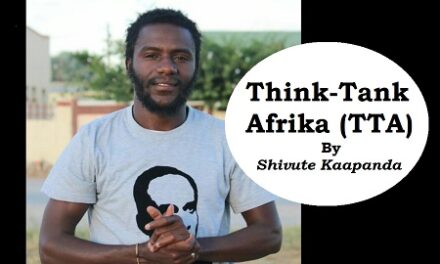Is Namibia a Gerontocracy?
By Shivute Kaapanda [Think Tank Africa]
In ancient history, Greek philosopher Plato famously stated that “it is for the elder man to rule and for the younger to submit”.
And, with that statement, there began a form of government system known as ‘gerontocracy’.
One of the best examples in history of Gerontocracy is the ancient Greek Gerontocracy which was seen in the city state of Sparta which was ruled by a Gerousia, a council made up of members who were at least 60 years of age and who served for life.
A Gerontocracy is a form of oligarch rule in which an entity is ruled by leaders who are significantly older than most of the adult population, that the political structures and power within the ruling class accumulates with age making the oldest individuals the holders of the most power.
Just in recent weeks, Nigeria’s 70 years old Bola Ahmed Tinubu from All Progressive Congress political party successfully emerged as a winner of a tense and closely fought contest for Nigeria’s presidency, a physically fragile individual hoping to save a fragile nation of Nigeria.
That is just an example of how Africa’s fragile economies are presided over by fragile souls. Much more surprisingly in Africa especially in Namibia there is always a minimum age limit for a person to occupy an office of presidency but unfortunately in a Gerontocracy there is no maximum age limit, a country can effectively have a president who is 100 years old.
In Africa “with age comes wisdom” is often the common metaphor used to justify Gerontocracy, not knowing that such a metaphor was not necessarily coined for defining political public offices bearing but it was seen in a context of giving wisdom to the young ones in the villages.
In Namibia, the age of retirement from public service is 60 years, which means after the age of 60 or 65 a person occupying a public office is supposed to retire officially and receive a monthly N$1400 pension as per law, but we have people retiring as school principals at age 60 and becoming ministers at 70.
Like in a bourgeois state, the law in Namibia fully shelters Gerontocracy.
Look at the following examples of Namibian presidents: Dr. Sam Nujoma at the age of 61 became the first president of Namibia in 1990; Dr. Hifikepunye Pohamba at the age of 69 was the second president, and Dr. Hage Geingob at age 74 became Namibia’s 3rd president.
And yet, still, according to the wishes of the gerontocratic SWAPO party the next president should be Madam Netumbo Nandi-Ndaitwah, to assume office at age 73.
It appears that even the age margin has kept increasing for the sake of appeasing the “with age comes wisdom” narrative. The youngest president Namibia has ever produced was 61 years old in 1990.
In Namibia, we are in actual fact ruled by pensioners; the cabinet which is the executive political class is effectively an old age home.
It is quite saddening that the liberation mantra deprived Namibia to ever have a youthful president and that the country continue to have elderly presidents and cabinet ministers due to the fact that the nature of accommodating the liberation struggle family into key political offices for whatever fear is still persisting.
The gerontocratic nature of the SWAPO government effectively promotes the purposes of keeping political power in old hands by keeping the younger leaders at the periphery of key political leadership positions.
Those that are by chance wheelchaired into the system as young leaders are either just appointed and not elected and therefore have no voting powers. Many young people were having much hope in the SPYL to change the dynamics of leadership by grooming as many young leaders through the mother party but as toothless and submissive as it has been, like a Christian waiting for Jesus to come the SPYL continues to inspire the gerontocracy party by singing “youth are the leaders of tomorrow” song.
Namibians should wake up, we cannot continue to be led by fragile souls masquerading as wisdom carriers while it is obvious that at 70 the only thing one can successfully do is managing a cattle farm and not lead a 2 million diverse population.
Why would a legal retirement age stand at 60 years in public service but the president and the deputy president of a country are over the age of 70 years? Does this show that Namibian youth are easily gullible?
Namibian youth need to reject with outmost contempt the spirit of gerontocracy perpetuated by the Namibian government today.
How many cabinet ministers are below the age of 60 in Namibia despite young people being the majority? Has the intelligent youth population in Namibia really accepted the gullibility chorus of “youth are the leaders of tomorrow” only without embarking on any solid societal impact to destabilize the status quo of gerontocracy?
One does not need a microscope to see if Namibia is a state politically governed by the minority elderly class of society, one only need to look at how old is the country’s president, the deputy president and the prime minister.
The elderly are indeed drunk on political power since 1990 political independence.
To challenge the state of gerontocracy in Namibia the youth need to stand up to dismantle the chain of gerontocracy by any means necessary because power is never given but it’s rather taken.
The youth of Namibia need to wake up before things get worse in the hands of the current ancestor ruling class; the current gerontocratic leadership needs a litmus test of the 21st century organized and led by young people.
If there exists a minimum age limit for Namibians to occupy political office in Namibia, there should exist a maximum age too. The spirit of gerontocracy should fall forever.
– Shivute Kaapanda is an Activist writer from Eyanda village. He authored a book titled “The Conscious Republic” published in 2020. He can be contacted at iskaapanda@gmail.com






